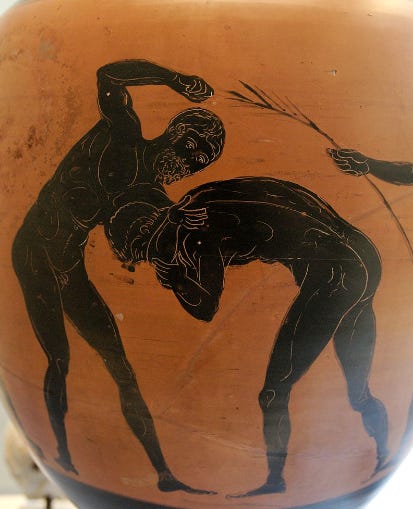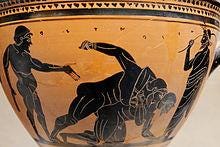The Ancient Olympics and the Pankration Competition: A fight to the death?
Gods, Minotaurs and all the gory details of the ancient Olympics' most violent event.
In Greek mythology, it was said that the heroes Heracles and Theseus invented pankration as a result of using both wrestling and boxing in their confrontations with opponents. Theseus was said to have used pankration to defeat Cercyon of Eleusis in a wrestling match, as well as the minotaur in the labyrinth. Heracles too was often depicted in ancient artworks subduing the Nemean lion using pankration.
The mainstream academic view has been that pankration developed in the archaic Greek society of the 7th century BC, whereby, as the need for expression in violent sport increased, pankration filled a niche of "total contest" that neither boxing nor wrestling could. However, some evidence suggests that pankration, in both its sporting form and its combative form, may have been practiced in Greece already from the second millennium BC.
Pankration: MMA (Mixed Martial Arts) First
Pankration, as practiced in historical antiquity, was an athletic event that combined techniques of both boxing (pygmē/pygmachia – πυγμή/πυγμαχία) and wrestling (palē – πάλη), as well as additional elements, such as the use of strikes with the legs, to create a broad fighting sport similar to today's mixed martial arts competitions. There is evidence that, although knockouts were common, most pankration competitions were decided on the basis of submission or yielding to a joint lock. However, in extreme cases a pankration competition could result in the death of one of the opponents, which was considered a win for the surviving combatant.
Soldiers Just Want To Have Fun
However, Pankration was more than just an event in the athletic competitions of the ancient Greek world; it was also part of the arsenal of Greek soldiers – including the famous Spartan hoplites and Alexander the Great's Macedonian phalanx. It is said that the Spartans at the Battle of Thermopylae fought with their bare hands and teeth once their swords and spears broke.
The feats of the ancient pankratiasts became legendary in the annals of Greek athletics. Stories abound of past champions who were considered invincible beings. Arrhichion, Dioxippus, Polydamas of Skotoussa and Theogenes (often referred to as Theagenes of Thasos after the first century AD) are among the most highly recognized names. Their accomplishments defying the odds were some of the most inspiring of ancient Greek athletics and they served as inspiration to the Hellenic world for centuries.
Dioxippus was an Athenian who had won the Olympic Games in 336 BC, and was serving in Alexander the Great's army in its expedition into Asia. As an admired champion, he naturally became part of the circle of Alexander the Great. In that context, he accepted a challenge from one of Alexander's most skilled soldiers named Coragus to fight in front of Alexander and the troops in armed combat. While Coragus fought with weapons and full armour, Dioxippus showed up armed only with a club and defeated Coragus without killing him, making use of his pankration skills.
Arrhichion: Champion in Death
In an odd turn of events, a pankration fighter named Arrhichion (Ἀρριχίων) of Phigalia won the pankration competition at the Olympic Games despite being dead. His opponent had locked him in a chokehold and Arrhichion, desperate to loosen it, broke his opponent's toe (some records say his ankle). The opponent nearly passed out from pain and submitted. As the referee raised Arrhichion's hand, it was discovered that he had died from the chokehold. His body was crowned with the olive wreath and returned to Phigaleia as a hero.










Timothy- Arrhichion's story is wild in the best sense of the word. I have not heard of this story. So this is a great find. I don't know what the physics and anatomy is for the body to remain in statis despite death (but maybe it's a chicken-egg question)? :)